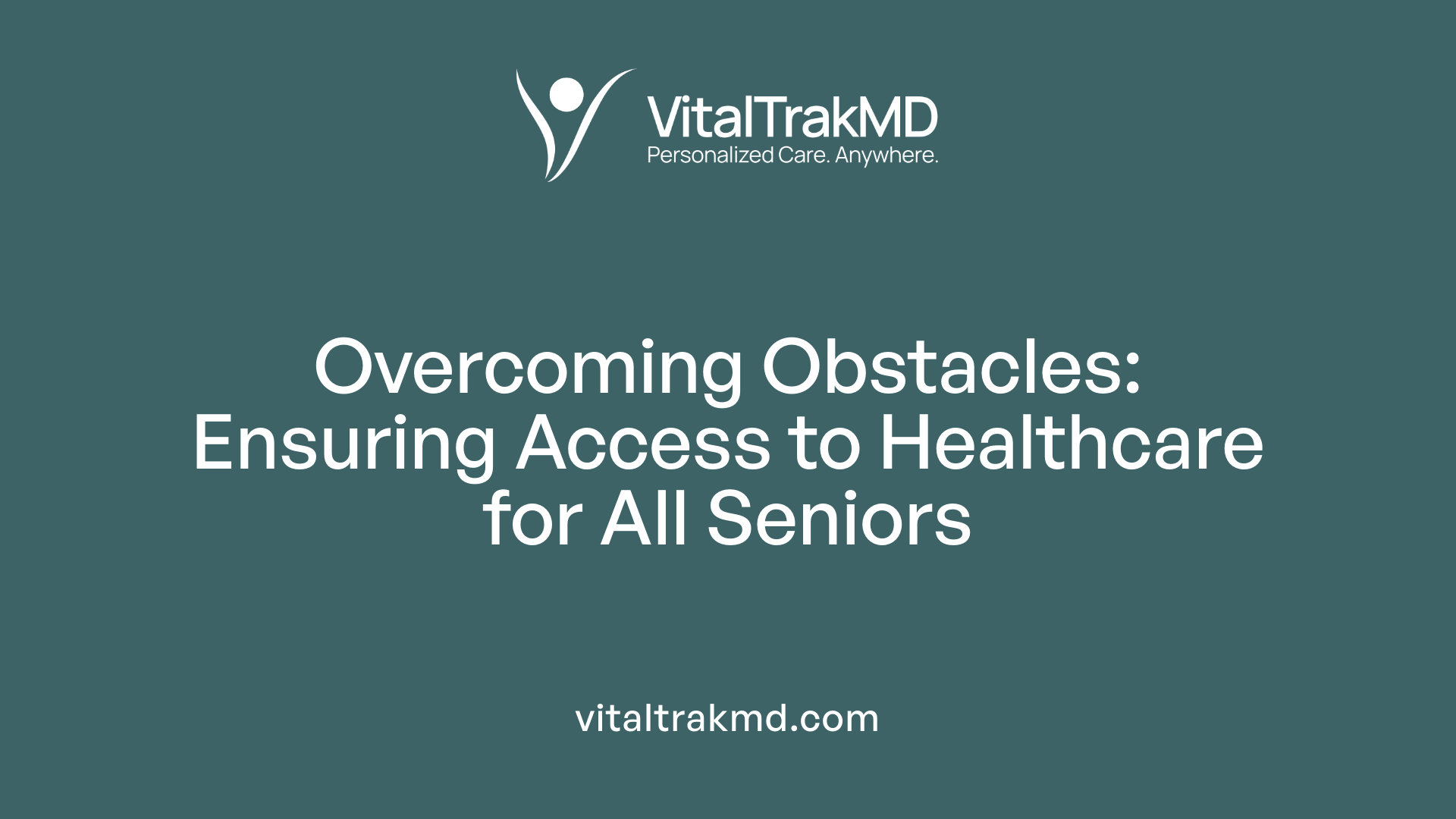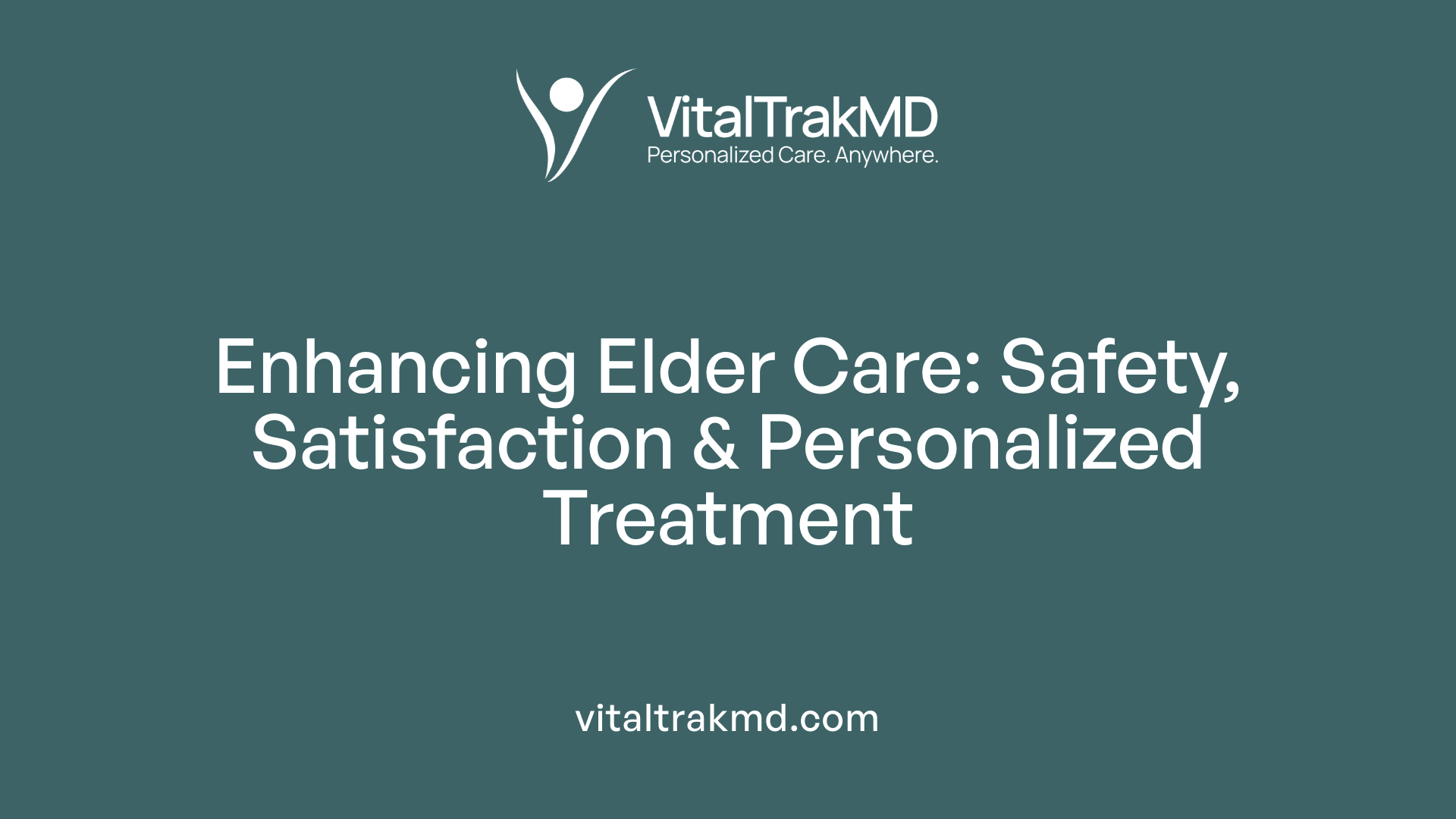Why Seniors Avoid Doctor Visits — And How Hybrid Care Solves That

Understanding the Barriers and Solutions to Senior Healthcare Access
Many seniors face significant obstacles in seeking regular healthcare, including mobility issues, transportation challenges, and technological gaps. The COVID-19 pandemic underscored the importance of flexible, safe, and accessible care options. Hybrid healthcare models, integrating telemedicine with in-person visits, are emerging as promising solutions to bridge these gaps, enhancing patient safety, satisfaction, and overall health outcomes.
Barriers to Traditional Healthcare Access for Older Adults

What barriers do older adults face in accessing traditional healthcare services?
Older adults encounter several obstacles that can hinder their ability to receive timely and effective healthcare. One of the primary challenges is physical limitations, such as mobility issues, chronic conditions, and general frailty, which often make traveling to medical appointments physically demanding.
Transportation problems are also significant. Many seniors lack reliable transportation options or face safety concerns when traveling on busy streets, especially in adverse weather or unsafe neighborhoods.
Psychological barriers can further impede access. Some older adults perceive healthcare providers as unresponsive or feel hesitant to communicate their needs clearly, leading to anxiety or reluctance to seek care.
Socioeconomic factors play a critical role as well. Low income, lack of insurance coverage, and residing in rural or underserved areas limit access to specialized care and affordable services. These barriers are compounded in regions with few healthcare facilities.
The complexity of the healthcare system itself can be confusing for older adults. Difficulties navigating appointment processes, insurance paperwork, or understanding available services can cause delays in care-seeking.
Lastly, digital divides and community-specific challenges exacerbate these issues. Limited access to internet, lack of digital literacy, cultural differences, and weak social support networks contribute to the disparities faced by many seniors.
Overall, addressing these barriers requires targeted community programs, improved transportation options, simplified healthcare navigation, and increased digital literacy efforts to ensure older adults can access the care they need.
Why Seniors Tend to Avoid Visiting Doctors
Many seniors choose not to visit healthcare providers for a variety of reasons. Commonly, fear and anxiety about medical procedures or the possibility of receiving bad news can deter them from seeking care. Concerns about costs, especially if they lack adequate insurance, also serve as significant barriers.
Logistical issues play a major role, including transportation difficulties, mobility limitations, and the challenge of accessing clinics, particularly for those with chronic conditions or in rural areas. Technological barriers further complicate matters; older adults may feel overwhelmed or unfamiliar with telehealth platforms, leading to hesitation in using digital health services.
Perceptions of care quality and communication gaps with healthcare providers can discourage seniors from engaging with the system. Feelings of neglect or experiences of discrimination within healthcare settings may also impact their willingness to seek help. Additionally, if symptoms are mild, many believe they do not need medical attention, especially when they think conditions might improve naturally.
In summary, a combination of emotional fears, economic concerns, logistical challenges, and systemic issues contribute to seniors avoiding doctor visits, which can lead to unmet health needs and delayed treatment.
How Telemedicine and Hybrid Care Models Enhance Access
How can hybrid care models, including telemedicine and virtual visits, improve healthcare access for older adults?
Hybrid care models combine traditional in-person visits with telemedicine and virtual health services. This approach broadens healthcare access, especially for seniors, by addressing geographical and logistical challenges.
Many older adults face barriers like long travel distances, limited transportation options, and mobility issues. Telehealth eliminates these obstacles by allowing virtual consultations from the comfort of home, reducing the need for travel and waiting times.
Remote monitoring tools play a crucial role, enabling continuous health data collection on blood pressure, glucose levels, and other vital signs. Physicians can detect early signs of health deterioration and intervene promptly, improving outcomes.
These models support aging in place with virtual rehabilitation programs, home hospitalization, and mental health services, helping seniors maintain independence while ensuring comprehensive care.
In rural or underserved areas, hybrid care facilitates faster specialist involvement. Local clinics equipped with medical assistants and connected to remote specialists create a seamless network, enhancing resource use and reducing healthcare disparities.
Overall, integrating telehealth with in-person services fosters a flexible, patient-centered healthcare system. It not only improves access but also promotes safety, better outcomes, and higher satisfaction among older adults by tailoring care to their unique needs.
| Benefit | Description | Additional Details |
|---|---|---|
| Overcoming geographic barriers | Telehealth enables care from any location | Especially beneficial in rural areas |
| Timely, personalized care | Virtual visits support early intervention | Reduces hospital readmissions |
| Continuous monitoring | Remote devices track health data | Supports Chronic disease management |
| Supporting aging in place | Virtual rehab and home hospital care | Keeps seniors independent |
| Rapid specialist access | Local clinics connect to specialists | Shortens wait times |
| Flexible, patient-centered systems | Combines in-person and virtual care | Customizable to individual needs |
This innovative model creates a scalable and efficient healthcare environment that addresses the diverse needs of older adults, ensuring they receive timely, safe, and effective care.
Implementing Hybrid Care Strategies for Better Utilization

What strategies can be used to implement hybrid care to improve healthcare utilization among seniors?
Implementing hybrid care models effectively involves a combination of approaches tailored to meet the diverse needs of older adults. One fundamental aspect is integrating telehealth into existing traditional practices. This integration allows for seamless virtual consultations alongside in-person visits, providing continuity of care while accommodating mobility issues and long travel distances faced by many seniors.
Engaging stakeholders, including patients, caregivers, healthcare providers, and community organizations, is crucial. Community partnerships can facilitate access to resources such as technology assistance and transportation services, making digital health solutions more accessible and acceptable.
Tailoring interventions based on local infrastructure, resources, and population characteristics is essential. Frameworks like PRISM (Practical, Robust Implementation and Sustainability Model) and RE-AIM (Reach, Effectiveness, Adoption, Implementation, Maintenance) help guide customization and systematic evaluation.
The usability and safety of technology are vital components. User-friendly platforms with simple interfaces can help older adults feel comfortable using telehealth tools. Addressing concerns like privacy, security, and the physical comfort of patients during virtual visits encourages ongoing engagement.
Training staff regularly on new workflows, digital tools, and communication techniques ensures high-quality service delivery. Continuous quality improvement processes, including feedback loops and supervision, support ongoing adaptation and staff competency.
Incorporating digital workflows such as online appointment scheduling, automated reminders, and two-way messaging streamlines processes and reduces administrative burdens. These systems enhance patient engagement and ensure timely care.
Finally, employing hybrid effectiveness-implementation strategies allows healthcare systems to monitor outcomes continuously. By evaluating both clinical results and process fidelity, providers can iteratively refine hybrid models, ensuring they remain scalable, sustainable, and truly patient-centered.
How can these strategies shape the future of senior healthcare?
Adopting well-structured hybrid care frameworks promises to improve healthcare access, reduce costs, and promote aging in place. With thoughtful planning, stakeholder involvement, and continuous assessment, hybrid models can become the standard approach for managing chronic conditions, preventive care, and complex health needs among older populations.
Benefits of Hybrid Healthcare for Seniors

What are the benefits of hybrid healthcare delivery for seniors?
Hybrid healthcare combines traditional in-person visits with virtual care options, creating a flexible, patient-centered approach suited for older adults. This model improves access to healthcare by reducing the need for travel and accommodating those with mobility challenges or transportation issues. Seniors can schedule virtual appointments for minor health concerns, follow-ups, or routine monitoring, while still attending in-person visits for comprehensive exams or complex procedures.
Safety is significantly enhanced through remote monitoring tools such as fall alerts, blood pressure monitors, and glucose tracking devices. These technologies help detect changes in health status early, potentially preventing hospitalizations or emergencies. Additionally, virtual check-ins and continuous data collection support timely interventions, contributing to safer aging and better management of chronic conditions.
Supporting independence and aging in place is a core advantage of hybrid care. Seniors can receive personalized support in familiar environments, preserving dignity and comfort. This approach fosters a sense of control over their health while maintaining social connections, which is vital for mental well-being.
Cost savings and logistical benefits also make hybrid healthcare attractive. By decreasing travel needs and reducing time spent in clinics, families and caregivers experience less financial and emotional strain. Moreover, flexible scheduling options and reduced waiting times create more convenient care experiences, encouraging ongoing engagement and adherence to treatment plans.
Importantly, this model promotes stronger relationships between seniors and healthcare providers. Through consistent virtual contact, healthcare teams can better understand the patient’s environment, preferences, and needs. This continuity helps build trust and improve communication, leading to more effective and responsive care.
Overall, hybrid healthcare for seniors supports a comprehensive, efficient, and accessible system that enhances health outcomes, promotes independence, and improves quality of life.
The Role of Telehealth During the COVID-19 Pandemic

How has telehealth been utilized during the COVID-19 pandemic to support senior healthcare?
During the COVID-19 pandemic, telehealth became a vital tool in maintaining healthcare services for older adults. It allowed for remote diagnosis, consultation, and health monitoring, significantly reducing the need for in-person visits and lowering the risk of virus transmission. Many seniors, especially those with mobility challenges or who are at high risk for severe COVID-19, could access their healthcare providers through video calls, phone consultations, and specialized digital platforms.
The pandemic accelerated telehealth adoption across various programs such as Medicare and Medicaid. Usage surged notably—Medicaid telehealth services increased fifteenfold and Medicare services by ten times—ensuring that older adults continued receiving necessary care despite restrictions and social distancing measures.
While telehealth offered numerous benefits, it also presented challenges. Infrastructure issues, including inconsistent internet access and technological limitations, created disparities among seniors based on regional and socioeconomic factors. Additionally, concerns about the quality of virtual care and privacy persisted.
Beyond clinical consultations, telehealth also provided psychological support and health education, helping older adults manage mental health issues stemming from isolation and uncertainty. Despite some hurdles, telehealth proved essential in supporting continuous, accessible, and safe healthcare for seniors during the pandemic, highlighting its potential for future integration in standard healthcare practices.
Enhancing Patient Safety, Satisfaction, and Experience with Hybrid Models

How can hybrid healthcare models improve patient safety, experience, and satisfaction among older adults?
Hybrid healthcare models combine virtual and in-person services, creating a more personalized and adaptable approach to elder care. By integrating remote monitoring, telemedicine consultations, and home hospitalization—such as those implemented in programs like Sheba Beyond and internal medicine home care—these models enable timely and proactive interventions. This reduces the likelihood of complications and hospital readmissions, which not only improves safety but also enhances overall satisfaction.
Patients and their families report feeling more involved and comfortable with this flexible care format. Increasingly, older adults value privacy and direct engagement, which can be better supported through a tailored mix of in-home visits and virtual check-ins. Technology plays a vital role here, providing continuous safety monitoring and efficient resource management. Moreover, hybrid models help alleviate workforce challenges, such as nurse burnout, by allowing healthcare providers to manage multiple patients remotely.
In essence, these combined strategies lead to a more responsive, patient-centric healthcare experience, improving safety outcomes and boosting satisfaction among older adults.
What are future directions and innovations in elder care involving hybrid healthcare approaches?
Looking ahead, elder care will evolve through the adoption of cutting-edge technologies like artificial intelligence (AI), Internet of Things (IoT) devices, and smart home systems. These innovations aim to deliver highly customized, proactive care that anticipates health issues before they escalate.
Community-based service models will expand, blending in-home support with virtual care platforms and multidisciplinary teams. Examples include enhanced physical therapy protocols using virtual or augmented reality and mental health support via telepsychology services, all aimed at promoting independence and quality of life.
Wearable health devices and remote sensors will offer real-time data, empowering providers to monitor vital signs, mobility, and safety concerns continuously. Advances in precision medicine will enable more targeted therapies, addressing age-related conditions effectively.
Together, these innovations promise to create a safer, more efficient elder care system that adapts to individual needs while addressing workforce shortages and protecting patient data.
The Future of Elder Care: Combining Technology and Compassion
The integration of hybrid care models marks a transformative shift in elder healthcare, addressing longstanding barriers and improving safety, accessibility, and patient satisfaction. As technology advances and healthcare systems adapt, personalized, flexible, and community-centered care approaches will become the norm, ultimately enabling seniors to enjoy healthier, more autonomous lives with dignity and support.
References
- Senior patients happy with telehealth and want it as care option
- Older adults' perspectives on primary care telemedicine during the ...
- How Telehealth is Transforming Primary Care for Seniors
- How the Hybrid Care Model is Transforming Patient Access
- Telemedicine in primary care of older adults: a qualitative study
- Actualizing Better Health And Health Care For Older Adults
- Hybrid telehealth and rural care - Physicians Practice
Recent articles
Want to Feel Better and Live Healthier?
Join hundreds of patients taking control of their health with personalized care that fits their life – not the other way around.
Rated 4.8/5 by 32+ customers







